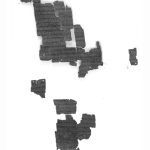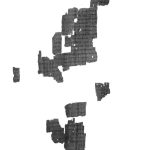| Artefact ID | 567 |
| TM ID | TM 61966 |
| Findspot (DEChriM ID) | - () | Class | Textual |
| Material | Papyrus |
| Writing medium | Codex |
| Text content | Literary |
| Language | Greek, Coptic |
| Description | Codex Freer Greek MS. V; Rahlfs WI; KV9; 34 folios from a papyrus codex containing the Minor Prophets with Coptic glosses. The codex is formatted in single quires, with one column per page. The quality of the papyrus is described as fine and thin, and appears to connect the texts of the Minor Prophets and the unknown text on prophesy; see ed. pr./Sanders. The number of lines per column ranges between 46 and 49 lines of text. The original size is estimated to have been 14 x 32 cm and the original expanse of the codex is suggested to have been 48 folios, of which 34 survived: Although no pagination is evident, the codex appears to have lost the 6 first folios as well as the 8 last folios already in antiquity; see ed. pr./Choat. The codex contains the works of the Minor Prophets. The identified texts belong to Hosea, Amos, Joel, Abdia, Jonas, Nahum, Habakuk, Sophonias, Aggeus, Zacharias, and Malachias. The large segment belonging to the Dodekapropheton is followed by an unidentified text on prophecy, which was probably a later addition and was copied onto the blank pages in the end of the codex; see ed. pr. The Coptic glosses (single words or short phrases) were written in the Sahidic dialect, which does not suit the proposed provenance of the Fayum. From this, the ed.pr./Choat suggests that the provenance should remain described as "unknown". The codex was the earliest Greek manuscript of the Minor Prophets known before the discovery of the Qumran scrolls; see ed. pr./Sanders. The scribe that produced the copy of the Minor prophets was apparently experienced: his hand is a professional majuscule with sometimes cursive tendencies, and was assumed to belong in the end of the 3rd century by the ed. pr./Sanders. There is also a second hand (1st corrector; possibly contemporary) and a 3rd hand (2nd corrector; a later addition), and possibly several later annotators (a fourth or even more hands of a later date). The first corrector, initially named a professional diorthotes (see the ed. pr./Sanders) is later recognized as the first owner of the manuscript who has made 274 meticulous (and probably contemporaneous) corrections to the manuscript; see ed. pr./Choat. The hand of the unidentified prophetic text is an informal, rightleaning majuscule, which can be blaced in the early 4th c. There are no accents or breathings, but some instances of diaereses. The text contains several nomina sacra. The unidentified text probably comprised pages 79–80 of the original codex, conjoined to pages 17/18 of the original codex containing Amos 4:1–5:15. The text includes inter alia a verbatim quote from Isa 54:12–15, citation from Ezek 40:2ff (possibly in the form of Symmachus) and perhaps also an indirect reference to Rev 21. The text was initially suggested to be a lost work on prophecy by Clement of Alexandria (or perhaps Origenes) (see Thackerey 1929), but the arguments for this has since been opposed and the ed. pr./Choat presents the identification of the text as still quite uncertain. |
| Selection criteria | Literary genre (Biblical), Literary genre (Theological), Nomina sacra |
| Date from | 250 |
| Date to | 399 |
| Dating criteria | Palaeography. Dated to the second half of the 3rd c. by the ed. pr. (Sanders), who also based the dating on a small piece of text internal evidence. This evidence was disputed by E. G. Turner, who in turn expanded the period of composition to include the 4th c.; see Turner 1977: 181 (OT 187) and page 59 n. *. In short, the main text of the Minor Prophets could have been copied in the end of the 3rd c. The marginal additions, glosses and final, unidentified text, however, appear to be a later addition. |
| Absolute/relative date | Relative date |
| Archaeological context | The provenance is unknown, yet the Arsinoites (Fayûm) have been suggested due to the manuscript's purchase history: the acquisition was described as from the Fayum by the antiquites dealer: see Choat 2006: 89. Charles Freer acquired the fragments in May 1916 from the antiquities dealer Maurice Nahman through the intermediary Dr. David Askren (an American Presbyterian missionary doctor): The purchase was a joint venture between Charles Freer and J.P. Morgan Jr., and was accomodated by Francis Kelsey. The fragments were retrieved from Egypt in 1920, and sent from Rome through the American Embassy to the Library of the University of Michigan, arriving in Michican on the 14th of May 1920; see Clarke 2006: 34. |
| Accession number | Washington, Smithsonian, Freer Gallery of Art, F 1916.768 / MS V |
ARTEFACT IDENTIFIERS
Editiones principes:
∙ Choat, Malcolm. 2006. "The Unidentified Text in the Freer Minor Prophets Codex". The Freer Biblical manuscripts. Hurtado, Larry W., ed. Leiden : Brill. 108-121.
∙ Sanders, Henry A. and Carl Schmidt. 1927. The minor prophets in the Freer collection and the Berlin fragment of Genesis. New York: NY Macmillan. 228-229.
Additional bibliography:
∙ Aland, Kurt. 1995. Repertorium der Griechischen Christlichen Papyri. II. Kirchenväter. Kirchenväter 9.
∙ Brown, M.P. 2006. In the beginning: Bibles before the year 1000. Washington D.C.: Freer Gallery of Art and Arthur M. Sackler Gallery, Smithsonian Institution. 119 and 253-254, record no. 10.
∙ Capasso, 2019. "". Pap. Congr. XXVIII (Barcelona 2016). 738.
∙ Clarke, Kent D. 2006. "Paleography and Philanthropy: Charles Lang Freer and His Acquisition of the “Freer Biblical Manuscripts”. The Freer Biblical manuscripts. Hurtado, Larry W., ed. Leiden : Brill. 17-74.
∙ de Troyer, K. 2006. "The Freer Twelve Minor Prophets Codex—A Case Study: The Old Greek Text of Jonah, Its Revisions, and Its Corrections ". The Freer Biblical Manuscripts. Hurtado, L., ed. Atlanta. 75-86.
∙ Nongbri, Brent. 2018. God's library: the archaeology of the earliest Christian manuscripts. New Haven : Yale university press.
∙ Rahlfs, Alfred and Detlef Fraenkel. 2004 (1914). Verzeichnis der griechischen Handschriften des Alten Testaments. Göttingen. 387-389, description W.
∙ Sanders, H. A. 1927. Facsimile of the Washington manuscript of the Minor Prophet. Ann Arbor (Michigan) : University of Michigan.
∙ Thackeray, Henry St.-J. 1929. “A Papyrus Scrap of Patristic Writing”. JTS 30. 179–90.
∙ Turner, Eric G. 1977. The Typology of the Early Codex. University of Pennsylvania Press.
∙ van Haelst, Joseph. 1976. Catalogue des papyrus littéraires juifs et chrétiens. Paris. Description no. 284 and 636.


 Json data
Json data





